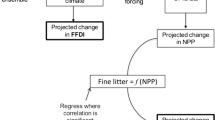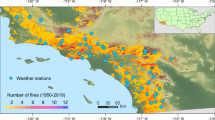Abstract
We explore the impact of future climate change on the risk of forest and grassland fires over Australia in January using a high resolution regional climate model, driven at the boundaries by data from a transitory coupled climate model. Two future emission scenarios (relatively high and relatively low) are used for 2050 and 2100 and four realizations for each time period and each emission scenario are run. Results show a consistent increase in regional-scale fire risk over Australia driven principally by warming and reductions in relative humidity in all simulations, under all emission scenarios and at all time periods. We calculate the probability density function for the fire risk for a single point in New South Wales and show that the probability of extreme fire risk increases by around 25% compared to the present day in 2050 under both relatively low and relatively high emissions, and that this increases by a further 20% under the relatively low emission scenario by 2100. The increase in the probability of extreme fire risk increases dramatically under the high emission scenario by 2100. Our results are broadly in-line with earlier analyses despite our use of a significantly different methodology and we therefore conclude that the likelihood of a significant increase in fire risk over Australia resulting from climate change is very high. While there is already substantial investment in fire-related management in Australia, our results indicate that this investment is likely to have to increase to maintain the present fire-related losses in Australia.
Similar content being viewed by others
References
AUSLIG (1990) Vegetation: atlas of Australian resources, 3rd Series, vol. 6. Australian Surveying and Land Information Group, Depart. Administrative Services, Canberra, p 64
Australian Bureau of Statistics (1995) ABS year book Australia 1995, (1301.0). ABS, Canberra, Australia
Beer T, Williams AA (1995) Estimating Australian forest fire danger under conditions of doubled carbon dioxide concentration. Clim Change 29:169–188
Blong R (2004) Residential building damage and natural perils: Australian examples and issues. Build Res Inf 32(5):379–390
Bureau of Meteorology (1984) Report on the meteorological aspects of the Ash Wednesday fires – 16 February 1983. Australian Government Public Service, Canberra, p 143
Cary GJ (2002) Importance of a changing climate for fire regimes in Australia. In: Bradstock RA, Williams JE, Gill MA (eds) Flammable Australia – The fire regimes and biodiversity of a continent. Cambridge University Press, pp 27–46
Cary GJ, Banks JCG (1999) Fire regime sensitivity to global climate change: an Australian perspective. In: Innes JL, Beniston M, Verstraete MM (eds) Biomass burning and its inter-relationship with the climate system. Kluwer, pp 233–246
Chen C, Cotton WR (1987) The physics of the marine strato-cumulus-capped mixed layer. J Atmos Sci 44:2951–2977
Chen D-X, Coughenor MB (1994) GEMTM: a general model for energy and mass transfer of land surfaces and its application at the FIFE sites. Agric For Meteorol 68:145–171
Clark JS (1990) Twentieth-century climate change, fire suppression, and forest production and decomposition in northwestern Minnesota. Can J For Res 20:219–232
Coghlan BJ (2004) The human health impact of the 2001–2002 “Black Christmas” bushfires in New South Wales, Australia: an alternative multidisciplinary strategy. J. Rural and Remote Environmental Health 3:18–28
Conroy RJ (1996) To burn or not to burn? A description of the history, nature and management of bushfires within Ku-Ring-Gai Chase national park. Proc Linn Soc NSW 116:79–95
CSIRO (1996) Climate change scenarios for the Australian region. CSIRO Division of Atmospheric Research, Melbourne, Australia
Denis B, Laprise R, Caya D (2003) Sensitivity of a regional climate model to the resolution of the lateral boundary conditions. Clim Dyn 20: doi:10.1007/s00382-002-0264-6
Eastman JL, Coughenor MB, Pielke RA Sr (2001) The regional effects of CO2 and landscape change using a coupled plant and meteorological model. Glob Chang Biol 7:797–815
Gaertner MA, Christensen OB, Prego JA, Polcher J, Gallardo C, Castro M (2001) The impact of deforestation on the hydrological cycle in the western Mediterranean: an ensemble study with two regional climate models. Clim Dyn 17:857–873
Gardner RH, Hargrove WW, Turner GM, Romme WH (1996) Climate change, disturbances and landscape dynamics. In: Walker B, Steffen W (eds) Global change and terrestrial ecosystems. Cambridge University Press, Cambridge, pp 149–172
Gero AF, Pitman AJ, Narisma GT, Jacobson C, Pielke RA (2006) The impact of land cover change on storms in the Sydney Basin, Australia. Glob Planet Change 54:57–78
Gill AM (1997) From “mosaic” burning to the understanding of the fire-dynamics of landscapes. In: McKaige BJ, Williams RJ, Waggitt WM (eds) Bush fires 97: proceedings of the Australasian bush fire conference, pp 89–94
Gill AM, Moore PHR (1994) Some ecological research perspectives on the disastrous Sydney fires of January 1994. Proc. Of the second International Conference on Forest Fire Research, volume 1, pp 63–72
Gill AM, Moore PHR (1998) Big versus small fires: the bush fires of greater Sydney, January 1994. In: Moreno JM (ed) Large forest fires. Backhuys, Leiden, pp 49–68
Giorgi F, Shields-Brodeur C, Bates GT (1994) Regional climate change scenarios over the United States produced with a nested regional climate model. J Climate 7:375–399
Houghton JT, Ding Y, Griggs DJ, Noger M, van der Linden PJ, Dai X, Maskell K, Johnson CA (eds) (2001) Climate change, 2001, The scientific basis. Contribution of Working Group 1 to the third assessment report of the Intergovernmental Panel on Climate Change. Cambridge University Press, Cambridge, UK, p 881
Hourigan M (2001) The value of the volunteer contribution, Consultant’s report to the Victorian Country Fire Authority cited in the CFA submission to the Economic Development Committee of the Parliament of Victoria
Jones RG, Murphy JM, Noguer M (1995) Simulation of climate change over Europe using a nested regional-climate model: I assessment of control climate, including sensitivity to location of lateral boundaries. Quart J Roy Meteorol Soc 121:1413–1449
Kain JS, Fritsch JM (1993) Convective parameterization for mesoscale models: The Kain–Fritsch scheme. The representation of cumulus convection in numerical models. Meteor Monogr 24:165–170
Kershaw AP, Clark JS, Gill AM, D’Costa DM (2002) A history of fire in Australia. In: Bradstock RA, Williams JE, Gill MA (eds) Flammable Australia – The fire regimes and biodiversity of a continent. Cambridge University Press, pp 3–25
Leung LR, Ghan SJ (1999) Pacific Northwest climate sensitivity simulated by a regional climate model driven by a GCM. Part I: control simulation. J Climate 12:2010–2030
Liston GE, Pielke RA Sr (2001) A climate version of the regional atmospheric modeling system. Theor Appl Climatol 68:155–173
Liu D, Tager IB, Balmes JR, Harrison RJ (1992) The effect of smoke inhalation on lung function and airway responsiveness in wildland fire fighters. Am Rev Respir Dis 146:1469–1473
McAneney KJ (2005) Australian bush fire: quantifying and pricing the risk to residential properties. In: Harrison RJ, Quinn S, Bryant EA (eds) Proceedings of the Symposium on planning for natural hazards – how can we mitigate the impacts? University of Wollongong, pp 13–21, 2–5th February, 2005
McArthur AG (1967) Fire behaviour in Eucalypt forest. Comm Aust Timb Bur Leaflet 100:25
McAvaney BJ, Covey C, Joussaume S, Kattsov V, Kitoh A, Ogana W, Pitman AJ, Weaver A, Wood RA, Zhao Z-C (2001) Model Evaluation, In Chapter 8 of Climate Change, 2001, The Scientific Basis. Contribution of Working Group 1 to the third assessment report of the Intergovernmental Panel on Climate Change. In: Houghton JT, Ding Y, Griggs DJ, Noger M, van der Linden PJ, Dai X, Maskell K, Johnson CA (eds). Cambridge University Press, Cambridge, UK
McCarthy MA, Cary GJ (2002) Fire regimes in landscapes: models and realities. In: Bradstock RA, Williams JE, Gill MA (eds) Flammable Australia – The fire regimes and biodiversity of a continent. Cambridge University Press, pp 77–94
McGregor JL, Gordon HB, Watterson I, Dix MR, Rotstayn LD (1993) The CSIRO 9-level atmospheric general circulation model. CSIRO Division of Atmospheric Research, Technical paper 26, CSIRO, Australia, p 89
McLeod R (2003) The inquiry into the Operational Response to the January 2003 Bush fires, http://www.cmd.act.gov.au/mcleod_inquiry/report.htm
Murphy JM, Sexton DM, Barnett DN, Jones GS, Webb MJ, Collins M, Stainforth DA (2004) Quantification of modelling uncertainties in a large ensemble of climate change simulations. Nature 430:768–772
Nakicenovic N, Alcamo J, Davis G, de Vries B, Fenhann J, Gaffin S, Gregory K, Grübler A, Jung T-Y, Kram T, La Rovere EL, Michaelis L, Mori S, Morita T, Pepper W, Pitcher H, Price L, Riahi K, Roehrl A, Rogner H-H, Sankovski A, Schlesinger M, Shukla P, Smith S, Swart R, van Rooijen S, Victor N, Dadi Z (2000) IPCC special report on emissions scenarios. Cambridge University Press, Cambridge, UK, p 599
Narisma GT, Pitman AJ (2003) The impact of 200 years of land cover change on the Australian near-surface climate. J Hydrometeorol 4:424–436
Narisma GT, Pitman AJ (2004) The effect of including biospheric feedbacks on the impact of land cover change over Australia. Earth Interact 8(5):1–28
Noble IR, Barry GAV, Gill AM (1980) McArthur’s fire-danger meters expressed as equations. Aust J Ecology 5:201–203
Oliver J, Britton NR, James MK (1984) The Ash Wednesday bush fires in Victoria: 16 February 1983, Disaster Invest. Rep. 7, Cent. for Disaster Stud., James Cook Univ., Townsville, Queensland, Australia
Palisade Corporation (2002) Guide to Using @RISK, Version 4.5, Feb. 2002, Newfield, NY, USA
Peel D, Pitman AJ, Hughes L, Narisma GT (2005) The impact of an explicit representation of Eucalyptus on the simulation of the January climate of Australia. Environ Model Softw 20:595–612
Pielke RA, Cotton WR, Walko RL, Tremback CG, Lyons WA, Grasso LD, Nicholls ME, Moran MD, Wesley DA, Lee TJ, Copeland JH (1992) A comprehensive meteorological modeling system-RAMS. Meteorol Atmos Phys 49:69–91
Pielke RA Sr, Avissar R, Raupach M, Dolman AJ, Zeng X, Denning AS (1998) Interactions between the atmosphere and terrestrial ecosystems: Influence on weather and climate. Glob Chang Biol 4:461–475
Pitman AJ, Narisma GT, Pielke R, Holbrook NJ (2004) The impact of land cover change on the climate of south west Western Australia. J Geophys Res 109:D18109 doi:10.1029/2003JD004347
Pittock B (ed) (2003) Climate change: an Australian guide to the science and potential impacts. Australian Greenhouse Gas Office, Commonwealth of Australia, p 239
Ramsay GC, McArthur NA, Dowling VP (1996) Building in a fire-prone environment: research on building survival in two major bush fires. Proc Linn Soc NSW 116:133–140
Sim M (2002) Bushfires: are we doing enough to reduce the human impact? Occ Env Med 59:215–216
Stainforth DA, Aina T, Christensen C, Collins M, Faull N, Frame DJ, Kettleborough JA, Knight S, Martin A, Murphy JM, Piani C, Sexton D, Smith LA, Spicer RA, Thorpe AJ, Allen MR (2005) Uncertainty in predictions of the climate response to rising levels of greenhouse gases. Nature 433:403–406
Vose D (1996) Quantitative risk analysis: a guide to Monte Carlo simulation modelling. Wiley, Chichester, p 328
Watterson I, Dix M (2003) Simulated changes due to global warming in daily precipitation means and extremes and their interpretation using the gamma distribution. J Geophys Res 108:4397 doi:10.1029/2002JD002928
Watterson IG, Dix MR, Gordon HB, McGregor JL (1995) The CSIRO 9-level atmospheric general circulation model and its equilibrium present and doubled CO2 climates. Aust Meteorol Mag 44:111–125
Wehner MF (2000) A method to aid in the determination of the sampling size of AGCM ensemble simulations. Clim Dyn 16:321–331
Whetton PH, Rayner PJ, Pittock AB, Haylock MR (1994) An assessment of possible climate change in the Australian region based on an intercomparison of general circulation modeling results. J Climate 7:441–463
Williams AA, Karoly DJ, Tapper N (2001) The sensitivity of Australian fire danger to climate change. Clim Change 49:171–191
Author information
Authors and Affiliations
Corresponding author
Rights and permissions
About this article
Cite this article
Pitman, A.J., Narisma, G.T. & McAneney, J. The impact of climate change on the risk of forest and grassland fires in Australia. Climatic Change 84, 383–401 (2007). https://doi.org/10.1007/s10584-007-9243-6
Received:
Accepted:
Published:
Issue Date:
DOI: https://doi.org/10.1007/s10584-007-9243-6




